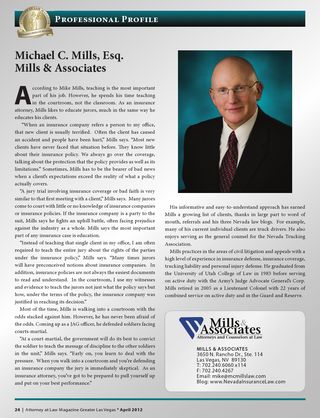Most if not all states have some sort of “Good Samaritan” law. These laws protect the “Good Samaritan” from later legal action against them if they negligently cause harm to the party they are trying to help. Lawmakers believe that this type of protection will encourage people to give help in an emergency.
Nevada’s “Good Samaritan” law, N.R.S. 41.500, was at issue in the Nevada Supreme Court case of Buck v. Greyhound, 105 Nev. 756, 783 P.2d 437 (1989). The Buck case involves an automobile / bus accident on dark and desolate Nevada highway. The Buck’s vehicle stalled in the middle of the road while attempting to make a U-turn and ended up blocking the north-bound travel lane. The purported “Good Samaritan” Reighley, happened upon the stalled car. Buck and Reighley decided that it would be best to leave the Buck vehicle where it had stalled in the road. They also turned turned off its headlights to conserve the battery. Reighley positioned his truck in the adjoining, southbound lane, keeping his headlights on in an attempt to warn any oncoming vehicles. Shortly thereafter, a northbound Greyhound bus collided with the stalled Buck vehicle, in spite of Reighley’s attempts to warn the bus by flashing his lights from the adjacent lane.
A jury eventually assessed Reighley’s fault at 25% regarding the damages ensuing from this accident. However, they also found he was protected by N.R.S. 41.500, Nevada’s “Good Samaritan” statute.
The Buck Plaintiffs who were injured in the accident thought that N.R.S. 41.500 did not apply to these circumstances and the jury instruction about the “Good Samaritan” law should not have been given. The Nevada Supreme Court agreed with two of the Buck’s arguments. First, an emergency did not exist at the time Reighley stopped to provide assistance. Factors constituting an “emergency” include: “suddenness, the unexpected, necessity for immediate action, and lack of time for a measured evaluation of alternative courses of action, their respective efficacy and priority.” The Court stated that the emergency that eventually arose was the product of Reighley’s own negligence. Second, the Court said that the history and language of the statute make it clear that it was intended to protect from liability those rendering aid to injured persons only.
Therefore, the protection of N.R.S. 41.500 was not applicable, as there was neither an emergency nor injured persons present at the time Reighley initially stopped to offer assistance, and then soon through his negligence made the situation far worse.
For more on the Buck case, click here.
 Follow
Follow Email
Email


